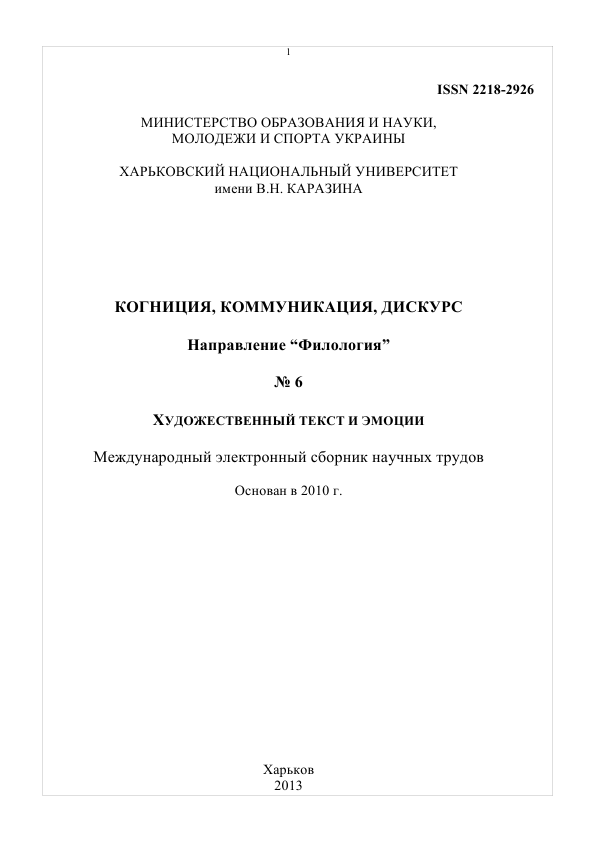Literary text as an object of scientific study: on relevance of cultural context
Abstract
This paper argues that studies of literary text are biased by a wide cultural context, and specifically by a scholarly paradigm as a part of culture. The author substantiates this idea with a number of examples from the history of science. It is maintained that the basic properties of literary text – its complexity and “manmeasured” nature – depend on characteristics of the scholar’s / interpreter’s environment. Diversity of construals in the studies of literary text is viewed as an exposure of humanizing and axiological vantages of contemporary thought.
Downloads
References
Воробьева О.П. Лингвистические аспекты адресованности художественного текста: Дис. ... д-ра филол. наук: 10.02.19 / Воробьева Ольга Петровна. – М., 1993а. – 382 с.
Воробьева О.П. Текстовые категории и фактор адресата / Воробьева О П. – Киев: Вища школа, 1993б. – 154 с.
Воробьева О.П. Модернистский дискурс: причуды и прозрения (на материале рассказов Вирджинии Вулф) / О.П. Воробьева // Язык и дискурс в статике и динамике: тезисы докладов Международной науч. конф. (Минск, 14–15 ноября 2008 г.) / «Минский гос. лингвистический. ун-т. – Минск, 2008. – С. 25–27.
Воробьева О.П. Словесная голография в пейзажном дискурсе Вирджинии Вулф: модусы, фракталы, фузии / О.П. Воробьева // Когниция, коммуникация, дискурс. Международный электронный сборник научных трудов. – 2010. – № 1. – С. 47–74.
Кубрякова Е.С. Эволюция лингвистических идей во второй половине ХХ века (опыт парадигмального анализа) / Е.С. Кубрякова // Язык и наука конца ХХ века. – М., 1995. – С. 144–238.
Кубрякова Е.С. О тексте и критериях его определения / Е. С. Кубрякова // Текст. Структура и семантика. Т. 1. – М., 2001. – С. 72–81 [Электронный ресурс] – Режим доступа к статье: http://www.philology.ru/linguistics1/kubryakova-01.htm
Кун Т. Структура научных революций / Кун Т. – М.: Изд-во АСТ, 2003. – 365 c.
Лотман Ю.М. Структура художественного текста / Лотман Ю.М. // Об искусстве. – СПб., 1998. – С. 13–285.
Лотман Ю.М. Семиотика и типология культуры / Ю.М. Лотман // История и типология русской культуры. – СПб, 2002. – С. 22–156.
Молчанова Г.Г. Английский как неродной: текст, стиль, культура, коммуникация / Молчанова Г.Г. – М.: ОЛМА Медиа Групп, 2007. – 384 с.
Отье-Ревю Ж. Явная и конститутивная неоднородность: к проблеме другого в дискурсе / Ж. Отье-Ревю // квадратура смысла: Французская школа анализа дискурса: сб. науч. ст. – М., 2002. – С. 54–81.
Поппер К. Предположения и опровержения: Рост научного знания / Поппер К. – М.: АСТ Ермак, 2004. – 638 с.
Фаулз Дж. А. Аристос / Дж. Фаулз. – М.: Эксмо, 2002. – 432 с.
Фейерабенд П. Избранные труды по методологии науки ; пер. с англ. и нем. / [под ред. И.С. Нарского, П. Фейерабенд]. – М.: Прогресс, 1986. – 542 с.
Фуко М. Археология знания /Фуко М. – Киев: Ника–Центр, 1996. – 280 с. [Электронный ресурс]. – Режим доступа к книге: http://www.gumer.info/bogoslov_Buks/Philos/fuko_arh/index.php
Шлейермахер Ф. Герменевтика / Шлейермахер Ф. – СПб.: Европейский Дом, 2004. – 242 с.
Щирова И.А. Проблема имманентности свойств текста в контексте антропологического поворота гуманитаристики / И.А. Щирова, Е.А. Гончарова // Многомерность текста: понимание и интерпретация. – СПб., 2007. – С. 103–114.
Щирова И.А. Описания свойств текста в терминах категорий. Категориальные модели текста / И.А. Щирова, Е.А. Гончарова // Многомерность текста: понимание и интерпретация. – СПб., 2007. – С. 92–103.
Dollimore J. Radical Tragedy. Religion, Ideology and Power in the Drama of Shakespeare and his Contemporaries. Third Edition. / Dollimore J. – New York: Palgrave MacMillan, 2004. – 312 p.
Collini S. Introduction: Interpretation terminable and interminable / S. Collini // Interpretation and overinterpretation. Umberto Eco with Richard Rorty, Jonathan Culler and Christine Brooke-Rose. – Cambridge, 1996. – P. 1–21.
Eco U. Interpretation and history / U. Eco // Interpretation and overinterpretation. Umberto Eco with Richard Rorty, Jonathan Culler and Christine Brooke-Rose. – Cambridge, 1996. – P. 23–43.
Gibert S. M. The Female Swerve / S. M. Gibert, S. Gubar // D. Righter. Falling into Theory. Conflicting Views on Reading Literature. – Boston, Ney York: Bedford / St. Martin’s, 2000. – P. 290–294.
Harris W. The Frontier on Which Heart of Darkness Stand / W. Harris // D. Righter. Falling into Theory. Conflicting Views on Reading Literature. – Boston, Ney York: Bedford / St. Martin’s, 2000. – P. 334–339.
Rorty R. The pragmatist’s progress / R. Rorty // Interpretation and overinterpretation. Umberto Eco with Richard Rorty, Jonathan Culler and Christine Brooke-Rose. – Cambridge: Cambridge University Press, 1996. – Р. 89– 08.
Selden R. A Reader’s Guide to Contemporary Literary Theory. Fifth edition / R. Selden, P. Widdowson, P. Brooker. – Harlow: Pearson / Longman, 2005. – 302 p.
Authors, who publish with this journal, accept the following conditions:
The authors reserve the copyright of their work and transfer to the journal the right of the first publication of this work under the terms of the Creative Commons Attribution License (CC BY), which allows other persons to freely distribute a published work with mandatory reference to the authors of the original work and the first publication of the work in this journal.
Authors have the right to enter into separate additional agreements for the non-exclusive dissemination of the work in the form in which it was published by this journal (for example, to post the work in the electronic institutions' repository or to publish as part of a monograph), provided that the link to the first publication of the work in this journal is given.
The journal policy allows and encourages the authors to place the manuscripts on the Internet (for example, in the institutions' repositories or on personal websites), both before the presentation of this manuscript to the editorial board and during review procedure, as it contributes to the creation of productive scientific discussion and positively affects the efficiency and dynamics of citing the published work (see The Effect of Open Access).




